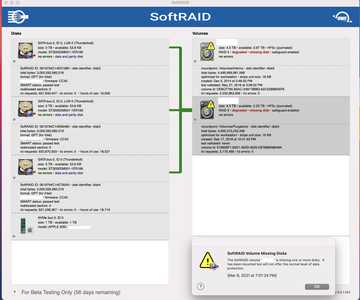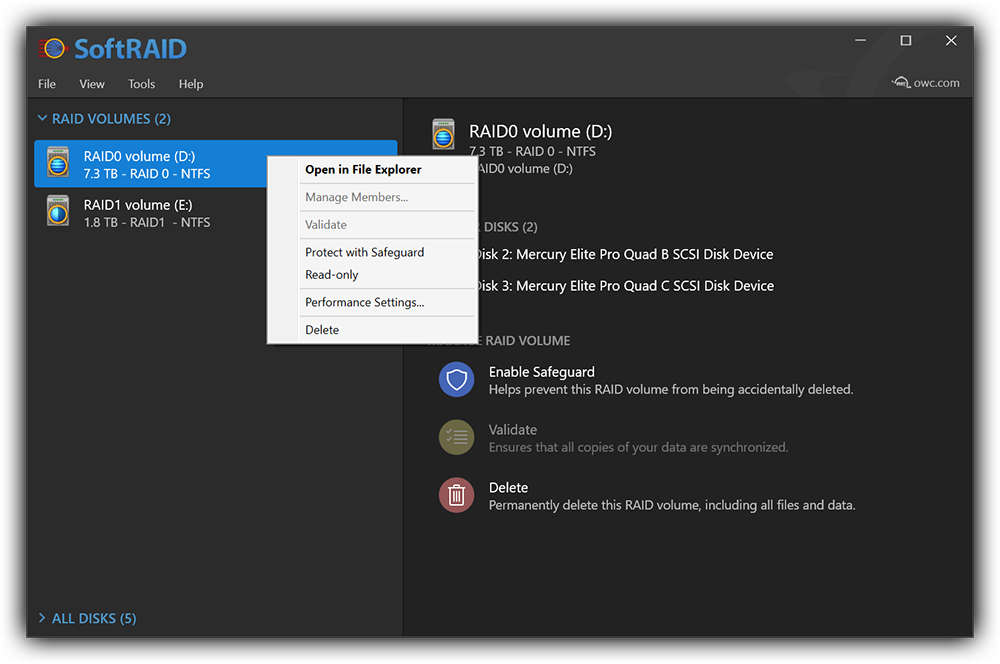

I guess you could mess this up if you decidedly don’t pay attention, but for most of us, disassembly takes just a few minutes. The all-metal construction is solid and everything fits nicely in place. Remove one Phillips screw on each side of the fan, lift the fan off and disconnect the power cable. Two Phillips screws on the back attach the cover to the innards. When you compare it in size to a typical 4-drive spinning media RAID, it is much smaller, quieter and lighter. The OWC Express 4M2 box contains the storage unit, power brick and AC cable and a high-quality 0.7 meter Thunderbolt cable. Storage ranges from about $200 (1 TB) to $1,520 (16 TB) If I didn’t already own a Thunderblade, I’d consider buying one of these for myself. If you need speed combined with greater storage than one SSD provides, the Express 4M2 is an excellent choice.

NOTE: If you want an SSD that is DEAD quiet, consider the Thunderblade which has no fan and no moving parts. I do not consider it in any way objectionable. However, putting my ear within inches of the unit, I did hear a low hum. Heat is dissipated using a 2″ fan that vents out the bottom of the unit. While no SSD has the capacity of spinning hard drives, no spinning media can touch these for speed, ruggedness and minimal noise. It also has a DisplayPort connection on the back to make it easy to attach a monitor directly to the unit. It has two Thunderbolt ports on the back so you can loop through this device to connect other Thunderbolt devices (up to six).
#SOFTRAID RAID 6 INSTALL#
Install the SSDs, plug the unit into wall power using a small power brick, connect it to a Thunderbolt port and you are ready to format it. But all parts seem to be high-quality and the ultimate fit is excellent. Installation is not for the fumble fingered – I dropped one itty-bitty screw and spent ten minutes searching for it. This all-metal enclosure is solidly-built, rugged and will last for years. NOTE: For best results, all four SSDs should match for model and storage capacity. I cover this in the Installation section below. While the unit ships without any storage, you can easily add up to four Aura P12 NVMe SSDs.
#SOFTRAID RAID 6 MAC#
It supports both Mac and Windows systems and is formatted by the end user.ĭepending upon how the system is formatted, it comes close to fully saturating a Thunderbolt 3 bus with speeds approaching 2,800 MB/second. Powered from the wall, it can be placed horizontally or vertically. The Linux also tests and reports optimal algorithm for RAID redundancy syndrome calculation for your system on boot, so you can check which one it will use and how fast it'll perform by reading boot logs.The OWC Express 4M2 NVMe SSD RAID holds up to 32 TB of storage, spread across four Aura NVMe SSDs. You can also limit its load by limiting the check rate by setting /sys/block/md125/md/sync_speed_max with some arbitrary value ( 200000, meaning 200 MB/sec is the default). This calculation is quite intensive for the CPU, so it's better to run this check when your system doesn't have much load.
#SOFTRAID RAID 6 SOFTWARE#
Linux software RAID uses a field that enables RAID6 with no more than 257 active devices (not counting hot spares). A second syndrome is calculated using quite sophisticated mathematics called Galois field. While first parity syndrome is really simply XOR, the second one is not. It is very useful to run the check periodically as it not only will correct misswrites, but also detect and kick out of array dying devices early, so better set up this check to be invoked via system scheduler (cron or systemd timers). You can monitor status via /proc/mdstat file or mdadm -detail /dev/md125. It'll report any important messages to kernel log readable via dmesg. This is important for modern very large disks. For RAID6 it will also correct a single-mismatch errors (when just one drive is went out of sync) by using all the rest drives, thanks to dual parity which enables detection of dual errors and correction of single errors, include those could have happened due to the disk bit error rate. It will read all the drives, compute parity stripes and check if they're correct. Run (replace md125 with your actual array): echo "check" > /sys/block/md125/md/sync_action


 0 kommentar(er)
0 kommentar(er)
